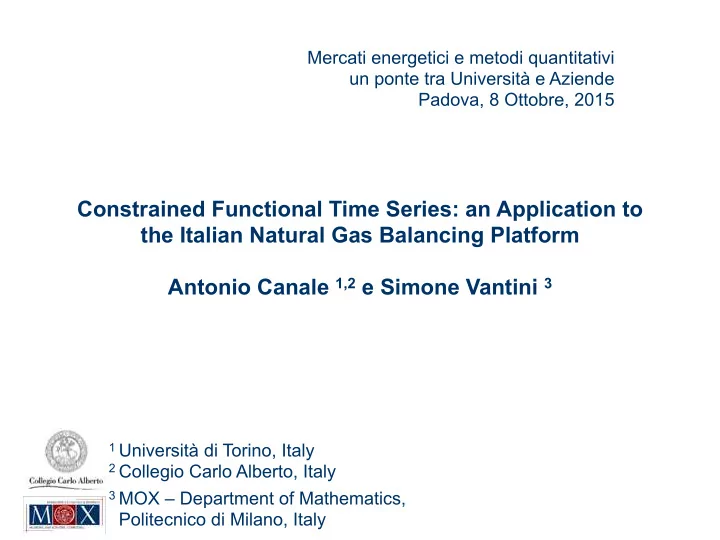

Mercati energetici e metodi quantitativi un ponte tra Università e Aziende Padova, 8 Ottobre, 2015 Constrained Functional Time Series: an Application to the Italian Natural Gas Balancing Platform Antonio Canale 1,2 e Simone Vantini 3 1 Università di Torino, Italy 2 Collegio Carlo Alberto, Italy 3 MOX – Department of Mathematics, Politecnico di Milano, Italy
The Infrastructure and the Shippers SNAM Rete Gas Gas Shippers One Large Few Medium-size Many Small
Main Issues Gas does not travel at “speed of light” Possible mismatch between the daily demand and the daily availability Risk of unbalance of the entire pipeline system Mitigation / adaptation and physical / normative strategies are used For example: • Injection / ejection of gas in geological traps (i.e., former oil or gas fields) • Liquefying / gasifying stations • Economic penalties for shippers based on their daily and monthly unbalance • Gas balancing platform or Mercato del Bilanciamento (i.e., a system in which gas shippers sell and buy natural gas already in the national pipeline)
Gas Balancing Platform: a toy example Demand Curve Six Buying Bids Supply Curve Four Selling Offers p* = 4.6 q* = 4.0
Why one-day ahead prediction? Why predict tomorrow exchange price p * ? Because it provides a threshold for having buying bids and selling offers accepted. Shippers want indeed to buy at low price or to sell at high price. [ Interested actors: Shippers ] Why predict tomorrow demand and supply curves p D (q) and p S (q) ? Because they give the possibility of introducing “non-standard” competitive strategies. By means of non-standard bids or offers, “big” shippers could manipulate p * and q * for saving/earning money and/or preventing competitors’ bids/offers to be accepted. [ Interested actors: Large and Medium-size Shippers ]
Non-standard strategies: a toy example Standard Standard buying bids and buying bids and selling offers selling offers Standard + + buying bids and selling my non standard buying my non standard buying offers bid ( p = 10, q = 3.5) bid ( p = 7.0, q = 3.5) X X V V p* = 4.6 p* = 10.0 p* = 7.0 q* = 4.0 q* = 6.0 q* = 6.0 I can buy 3.0 GJ at I can buy 3.0 GJ at 10 € /GJ about 7 € /GJ
Dataset Supply Curves Demand Curves
Dataset Description and Challenge • 395 demand and supply curves available (1 st Dec 2011 - 31 st Dec 2012) • monotonic non-decreasing / non-increasing • bounded at the right-edge of the domain • constrained at the left-edge of the domain • Possible covariates : • predicted unbalance • predicted temperature (…) • calendar date • Possible trend (first months removed) • Possible seasonality • Large derivatives • Strong temporal dependence One-day ahead prediction of functions subjected ( i ) to monotonicity constraint, ( ii ) to an equality constraint at the left-edge of the domain, and ( iii ) to an inequality constraint at the right-edge of the domain
The Method at a Glance transf. M 2 -FAR( p ) FAR( p ) inv. tran Constrained Space Unconstrained Sub-space of L 2 (a,b) (i.e., M 2 (a,b) ) (i.e., logH(M 2 (a,b)) )
Dealing with prediction of time-dependent functions Functional Autoregressive Models (i.e., FAR). This are autoregressive models in which the sequence of (1d) random variables is replaced by a sequence of functional random variables: I. Exponential Smoother or similar: Ψ j is a real number. II. Concurrent FAR( p ) : Ψ j is a function. III. Non-concurrent FAR( p ) : Ψ j is a Hilbert-Schmidt operator.
Results M 2 – Root Mean Square Error Scalar Root Mean Square Error
Reference Paper Canale, A., Vantini, S. (2014): " Constrained Functional Time Series: an Application to Demand and Supply Curves in the Italian Natural Gas Balancing Platform " Mox Report 42/2014, Department of Mathematics, Politecnico di Milano
Recommend
More recommend